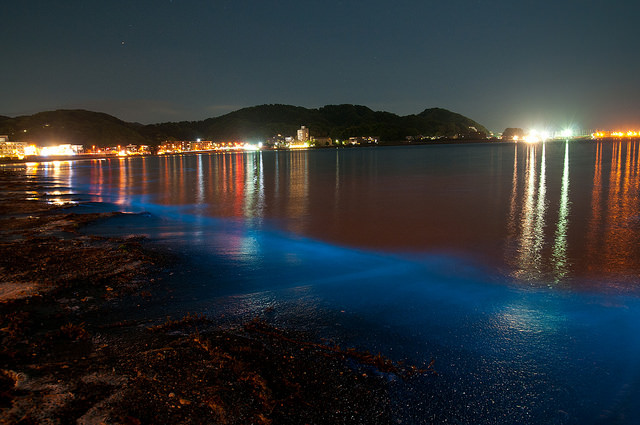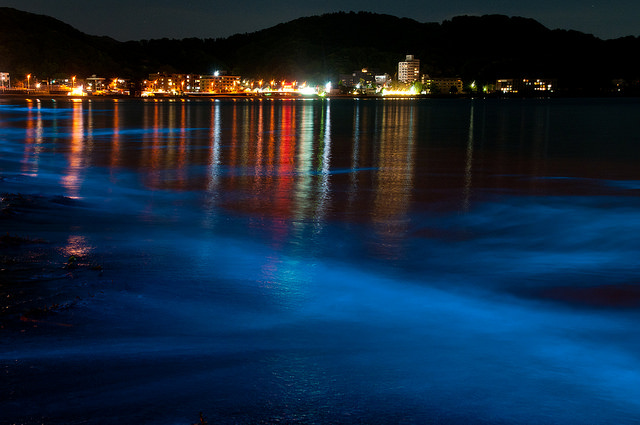
photo by Ken_ichi Kaizuka
Have you seen the movie “Life of Pi”? In this story, a young man named Pi survives a shipwreck in which he loses his family and drifts on a lifeboat in the Pacific Ocean with a Bengal tiger. One evening, he witnesses the sea water just beneath the lifeboat glimmering in neon blue and a whale jumps out of the glittering water. While this is such a beautiful fantastical scene, it seems like something unreal. But, leaving the jumping whale aside, this glimmering seawater is something you can actually see in real life, not just a fantasy. It is created by luminous marine plankton commonly known as the sea sparkle. An individual cell is just 1-2mm of the size, but abnormal growth of such plankton makes the seawater shine in bright blue. When and where can we see this scenery?
About the sea sparkle

photo by theguardian
The sea sparkle are plankton in 1-2mm round shape that commonly dwell in the oceans around Japan. They are known for emitting light by physical stimuli and a mass of sea sparkles often illuminates the seawater bright blue in the evening. It also reacts by emitting blue lights when a boat disturbs the surface of the water or an object is thrown in the water.
A cause of red tide
Surfs illuminated in neon blue creates such a beautiful scenery at the night time. But this is a result of a mass production of marine plankton. What else is caused by abnormal growth of plankton? Red tide. The sea sparkles are emitting light during the daytime, of course, but you can’t recognize its faint light under the sunlight. Instead, it turns the seawater its original color red. You might be surprised by the differences of the color of the sea between day and night, as the color of the water often looks as red as tomato juice during the daytime.
The best time of year for sea sparkle watching
The sea sparkles population in the water generally increases from spring to summer, when seawater temperature rises. The warmed seawater creates a better breeding ground for plankton. Generally speaking, a red tide tend to occur in the sea polluted with waste water from households or manufacturing facilities as it increases the nutrient level of the seawater. However, the sea sparkles are not necessarily affected by the nutritionally enriched seawater. They appears in any seas around Japan, without being limited to metropolitan and industrial areas. Instead, they tend to be blown into bays or coastlines or appear close to the ocean surface because of their rather large and light figures. The sea sparkles can be viewed at beaches or coastlines all over Japan, from Okinawa to Hokkaido.
How to enjoy

photo by Ken_ichi Kaizuka
Just watching waves glimmering in bright blue and hitting the shore is a great fun, of course. You can just check red tide info on the weather forecasts and head to the site. You can also throw little pebbles in the water to enjoy blue splashes, or stomp and leave blue foot prints on the shore. Or, what about cruising on the water to view the blue lines between surfs after a boat runs. During the season, many diving equipment shops or marine sports clubs offer sea sparkle watching tours in which you can watch the glimmering seawater from the deck of the boat or enjoy snorkeling in the night water. Websites linked below is examples of those shops and clubs.
Marine club Nagi (Okinawa, snorkeling experience)
Ine Tourism Association (Kyoto, Sea sparkle watching tour)
K.I.Craft (Aichi, Night time kayaking)
Diving Shop Little Ritz Izu (Shizuoka, Sea sparkle watching tour)
Ocean Days (Hokkaido, Sea sparkle watching tour)
Reminders
There are a few things you need to keep in your mind when you go out for sea sparkle watching.
Odor
Remember the beautiful blue shines on the sea is produced by a mass of plankton. You will notice the strong smell of the ocean caused by marine plankton. Don’t soak your outfit if you dislike the smell otherwise the odor will linger on your clothes.
Avoid external lights
The light produced by the sea sparkles is very faint. Any external lights may ruin the beauty of sea sparkles.
Not good occasion for fishing
You might think doing fishing and watching sea sparkles at the same time is a good idea. Well, it is not, actually. You can’t expect lots of fish on your hook when there are lots of plankton in the water that shorten oxygen.
It doesn’t shine in rough water
The sea sparkles emits light by physical stimuli, but it can’t shine when over stimulated. You can’t expect the shining blue water under the rough weather.
It’s hard to believe, isn’t it?
The sea sparkles, the gem stones in the dark night sea. Surprisingly, these are commonly seen views over a few months from spring to summer. Unlike other marine creatures such as firefly squids that dwell in limited areas, you can see the sea sparkles in your closest ocean. Why don’t you enjoy quick sea sparkle watching while you go out for a drive or walking?
